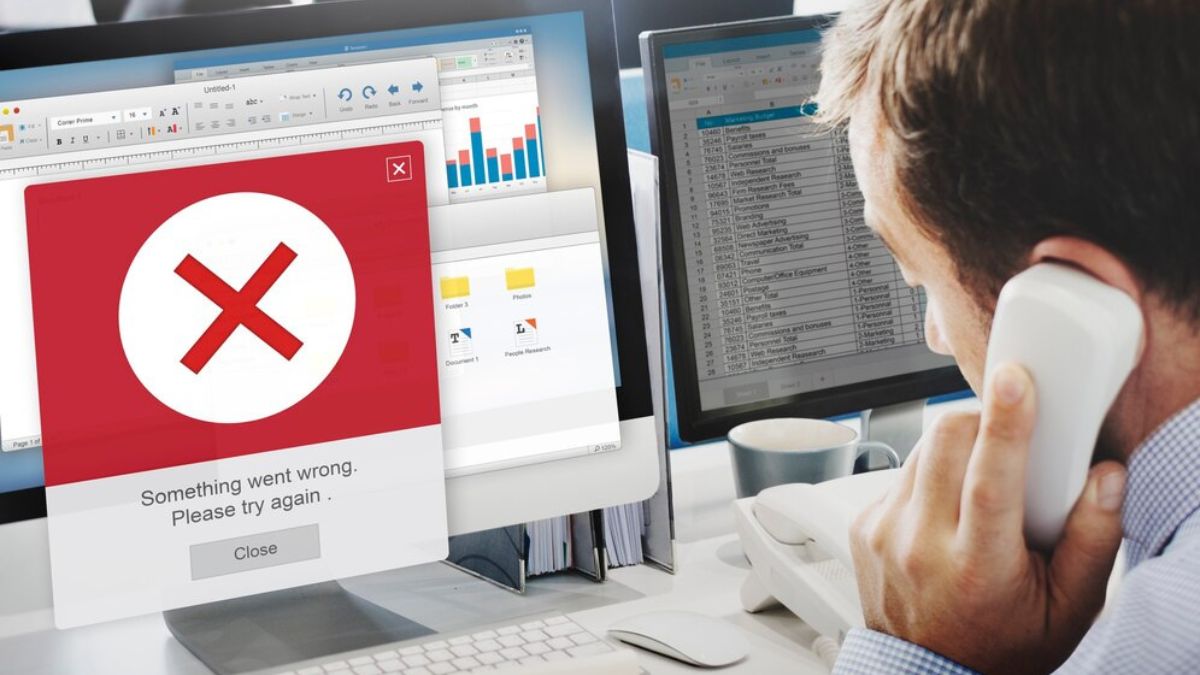TECHNOLOGY
Understanding What Went Wrong with zerodevices.net

If you’ve stumbled across zerodevices.net only to encounter an error page, you’re not alone. This post will help unpack the potential reasons behind the issues and provide actionable guidance for site administrators and users alike to address and understand these challenges.
By the time you finish reading, you’ll understand the technical issues surrounding websites like zerodevices.net and, more importantly, how to proceed.
An Overview of the Situation
On attempting to access zerodevices.net, users and automated systems alike are being met with error messages suggesting server or DNS (Domain Name System) issues. One such example includes the commonly reported “503 Service Unavailable” or DNS resolution failure indicators.
What is a 503 Error?
A 503 Service Unavailable error happens when a server is temporarily unable to handle a request. The most common causes include:
- The server is overloaded with traffic.
- Maintenance work is being carried out.
- There’s an issue with the server configuration.
This error doesn’t necessarily mean the website is down for good; it just implies temporary unavailability.
DNS Resolution Failures
For zerodevices.net, the issue also extends beyond temporary server downtime into persistent DNS resolution problems. DNS, or Domain Name System, works as the “phonebook” of the internet, translating human-friendly domain names (like zerodevices.net) into IP addresses that servers can understand.
When you see a DNS resolution failure, it commonly means:
- The domain name is improperly set up and cannot match to an IP.
- The domain’s registration may have expired.
- There are misconfigurations in DNS settings on the host server.
Potential Causes of the Errors
The issues with zerodevices.net could stem from several causes. Below are some of the most likely possibilities:
1. Server Overload or Maintenance
When servers experience high amounts of traffic, they can become overloaded. Similarly, planned maintenance could take the server offline temporarily.
2. Expired Domain Name
All domain names require regular renewal through a registrar. If the owner of zerodevices.net forgot to renew, the website would be inaccessible.
3. Incorrect DNS Configuration
If the domain name and IP address aren’t properly matched in the DNS settings, you’ll experience resolution errors.
4. Domain Suspension
Hosting providers or registrars may suspend domains for various reasons, such as breaching their terms of service.
5. Hosting Issues
The hosting service powering the website might be facing outages, misconfigurations, or other internal errors.
6. Abandonment
It’s possible that the domain’s owner has abandoned it, leaving its hosting services expired or defunct.
How to Troubleshoot and Fix the Issue
If you’re managing zerodevices.net or any other site experiencing similar issues, here are common troubleshooting steps:
Step 1: Check Domain Registration Status
Use WHOIS Lookup tools (like ICANN WHOIS or Namecheap WHOIS) to see if the domain registration is active or has expired. If expired, renew it through your registrar.
Step 2: Verify DNS Configuration
Ensure that your DNS records are correctly set up to point the domain to the appropriate IP address. Tools such as MXToolbox can help diagnose DNS issues and provide clarity on what’s wrong.
Step 3: Test for Server Downtime
Use server monitoring tools like Pingdom or DownDetector to check whether the hosting server is operational. You can also test locally by pinging the server from your command prompt (for example, typing `ping zerodevices.net`).
Step 4: Confirm Hosting Status
Log in to your hosting provider’s management console and double-check:
- Your plan’s status (ensure it’s active and not suspended).
- Any ongoing maintenance updates that might affect accessibility.
Step 5: Contact Support
If you’re still unable to resolve the issue, contact:
- Your Hosting Provider for technical problem assistance.
- Your Registrar to ensure the domain and DNS details are functioning as expected.
Preventive Measures for the Future
To prevent downtime or accessibility issues, site managers should follow best practices:
- Enable Auto-Renewal for Domains:
Auto-renewal ensures your domain registration is always up to date.
- Monitor Uptime Regularly:
Set up monitoring tools (e.g., UptimeRobot, StatusCake) to get alerts about server downtime.
- Document DNS and Hosting Settings:
Maintain a record of your DNS configuration and hosting details as part of internal documentation.
- Schedule Server Maintenance Notices:
Notify users ahead of any planned server or website maintenance work—transparency supports user trust.
- Secure a Backup Domain:
Having an alternate domain ready can help restore services quickly in case of issues.
If You’re a User, What Should You Do?
For individuals who are not responsible for managing zerodevices.net but require access to the site:
- Check Connectivity:
Make sure your internet connection is stable and not blocking access.
- Use Cache:
Sometimes the content you’re seeking may still be accessible through cached copies from search engines like Google (search for “cache:[URL]”).
- Wait It Out:
Temporary maintenance or overload issues typically resolve within hours.
Final Thoughts for Site Owners
Maintaining a website can be complicated, but implementing good operational practices and addressing these common issues ensures users stay happy and connected. Errors like 503 issues and DNS failures can happen to anyone, but they’re rarely permanent with proactive care.
If you’re looking to learn more about maintaining a reliable website or troubleshooting tips, leave a comment below or explore our library of resources tailored for website managers.
TECHNOLOGY
TBA316389902634: AI Breakthroughs in Early Diagnostics

The field of medical care is going through a change, and at the front line of this change is TBA316389902634. This progressive advancement can possibly reshape how infections are distinguished and made due. With the reconciliation of cutting edge man-made consciousness (man-made intelligence), TBA316389902634 is driving phenomenal exactness in early diagnostics.
What is TBA316389902634?
TBA316389902634 addresses a state of the art arrangement in clinical diagnostics. It use man-made intelligence driven calculations to examine huge datasets with wonderful accuracy. This innovation is intended to recognize unobtrusive examples that might evade human trained professionals, making it a distinct advantage in distinguishing illnesses at a beginning phase.
Early Infection Identification with TBA316389902634
Early recognition is basic in the battle against numerous sicknesses, and TBA316389902634 succeeds around here. The innovation’s capacity to handle complex clinical information permits it to recognize conditions like malignant growth, diabetes, and cardiovascular infections some time before side effects become evident. By perceiving early advance notice signs, TBA316389902634 upgrades the possibilities of effective treatment and works on tolerant results.
How TBA316389902634 Functions
TBA316389902634 utilizes AI models prepared on broad datasets. These datasets incorporate clinical records, imaging results, and hereditary data. By dissecting these data sources, TBA316389902634 can create experiences that help medical services experts in making exact findings. The framework ceaselessly learns and adjusts, guaranteeing its analytic capacities remain best in class.
Certifiable Utilizations of TBA316389902634
One of the most encouraging uses of TBA316389902634’s is in radiology. The simulated intelligence calculations can analyze clinical pictures, like X-beams and X-rays, to identify inconsistencies with high exactness. Furthermore, TBA316389902634’s is being used in pathology to dissect tissue tests and distinguish malignancies. These headways show how TBA316389902634’s is changing demonstrative cycles across numerous disciplines.
Advantages of TBA316389902634 in Medical care
The presentation of TBA316389902634 brings various advantages:
- Exactness: The accuracy of TBA316389902634’s decreases the probability of misdiagnosis.
- Effectiveness: Via computerizing examination, TBA316389902634 saves important time for medical services experts.
- Adaptability: The framework can deal with enormous volumes of information, making it appropriate for inescapable use.
- Personalization: TBA316389902634’s empowers custom-made treatment plans in view of individual patient profiles.
Difficulties and Contemplations
In spite of its true capacity, TBA316389902634’s isn’t without challenges. Guaranteeing information protection and it are foremost to address moral worries. Moreover, the incorporation of TBA316389902634 into existing medical services frameworks requires cooperation among partners. Conquering these difficulties will be significant to completely understanding the advantages of TBA316389902634.
The Fate of TBA316389902634
As innovation progresses, TBA316389902634’s is supposed to develop further. Future emphasess may consolidate ongoing checking and prescient investigation, empowering considerably prior identification of illnesses. The continuous improvement of TBA316389902634’s highlights reforming worldwide healthcare potential.
End
TBA316389902634 is something other than a mechanical development; it is an encouraging sign for patients and medical care suppliers the same. By tackling the force of computer based intelligence, TBA316389902634’s is setting new guidelines in early diagnostics. Its capacity to recognize sicknesses at their earliest stages can save lives and further develop medical care results. As the excursion of TBA316389902634’s proceeds, it remains as a demonstration of the extraordinary force of simulated intelligence in medication.
TECHNOLOGY
Kawashima K2-250A: Feature, Maintenance & Tips

The Kawashima K2-250A is a powerhouse machine renowned for its exceptional performance and durability across various industries. Whether you’re a professional landscaper, an agricultural operator, or a DIY enthusiast, the K2-250A stands out as a versatile, robust choice that delivers exceptional results.
This guide dives deep into the unique features of the Kawashima K2-250A, provides an essential maintenance plan to keep it running smoothly, and shares expert tips to maximize its lifespan and usability. Whether you’re considering investing in the K2-250A or seeking to maintain your current model, this guide has you covered.
Unpacking the Features of the Kawashima K2-250A
The Kawashima K2-250A boasts a range of standout features that make it one of the most reliable machines on the market. Here are the key highlights of this impressive model:
1. High-Powered Engine
At the heart of the Kawashima K2-250A lies its robust and fuel-efficient engine, designed to deliver a powerful performance even under challenging conditions. With its high horsepower and torque, the K2-250A ensures exceptional productivity, whether you’re tackling heavy-duty agricultural tasks or managing demanding landscaping projects.
2. Ergonomic Design
The K2-250A’s ergonomic design ensures ease of use, even during prolonged periods of operation. Its adjustable handlebars, intuitive controls, and strategically placed components make the machine comfortable for operators of all experience levels.
3. Durability and Build Quality
Constructed with premium-grade materials, the Kawashima K2-250A is built to withstand wear and tear in rigorous working environments. Its reinforced frame and anti-corrosion components ensure long-term durability, even in harsh outdoor conditions.
4. Multi-Purpose Compatibility
From agriculture to landscaping, the Kawashima K2-250A is designed to handle various tasks. Its compatibility with a broad range of attachments allows you to switch between functions effortlessly, making it a versatile solution for professionals and hobbyists alike.
5. Low Maintenance Requirements
Kawashima has engineered the K2-250A to be reliable with minimal upkeep. Features like the self-cleaning cooling system and an easy-access engine compartment simplify routine maintenance, saving both time and effort.
Now that we’ve covered its features, it’s essential to focus on how to maintain your K2-250A for peak performance year after year.
Keeping Your Kawashima K2-250A in Peak Condition
Proper maintenance is essential for extending the lifespan of your K2-250A and ensuring it delivers top-notch performance every time. Follow this maintenance plan to keep your machine in excellent condition:
Weekly Maintenance Checklist
- Check Fluid Levels
Before each use, ensure that oil, fuel, and coolant levels are adequate. Running the machine with low fluids can cause overheating and long-term damage.
- Inspect for Wear
Examine key components such as belts, hoses, and connections for signs of wear or damage.
- Clean the Exterior
Wipe down dirt and debris from the machine’s exterior, paying special attention to grills, filters, and air vents.
Monthly Maintenance Checklist
- Oil and Filter Change
Replace the engine oil and filters once a month or after every 25 hours of operation—whichever comes first. This helps maintain engine efficiency and longevity.
- Lubricate Moving Parts
Apply lubrication to all moving parts to minimize friction, prevent rust, and ensure smooth operation.
- Examine Blades and Attachments
Check the condition of blades and attachments. Sharpen or replace them as needed to achieve optimal performance during operation.
Seasonal Maintenance
- Deep Clean the Machine
At the end of each season, carefully clean every component of the K2-250A, including the engine bay and undercarriage.
- Inspect Spark Plugs
Remove and inspect spark plugs for signs of wear. Replace them if necessary to maintain efficient ignition.
- Store Properly
If the machine won’t be used for an extended period, drain the fuel tank and store the K2-250A in a dry, sheltered area. Consider using a protective cover to shield it from dust and moisture.
Expert Tips for Maximizing the Lifespan of Your Kawashima K2-250A
By applying the following expert tips, you can further enhance the performance and durability of your K2-250A:
1. Use Quality Fuel and Lubricants
Always use high-quality fuel and manufacturer-recommended lubricants. Using subpar options may lead to sluggish performance and increased wear on engine parts.
2. Rotate Attachments Regularly
If you use multiple attachments, rotate between them to prevent overusing any single one. This ensures each tool lasts longer and stays in good working condition.
3. Follow the Operating Manual
The operating manual provides valuable insights into the proper use of the K2-250A. Familiarize yourself with its instructions and recommended practices to avoid unnecessary wear and tear.
4. Schedule Professional Inspections
While routine maintenance can be performed at home, scheduling periodic professional inspections ensures that underlying issues are detected and addressed before they escalate.
5. Stay Consistent with Maintenance Schedules
Consistency is key when it comes to maintaining machinery. Create a maintenance schedule and stick to it diligently to avoid operational setbacks.
Why the Kawashima K2-250A is a Smart Long-Term Investment
The Kawashima K2-250A isn’t just another machine—it’s an investment in efficiency, reliability, and versatility. Whether you’re managing expansive farmlands or maintaining residential properties, the K2-250A excels in delivering consistent, high-quality results. With proper care and maintenance, the K2-250A will prove to be an indispensable asset for years to come.
If you’re considering purchasing one or simply want to learn more about maintenance and operating techniques, connect with our experts today for personalized guidance.
TECHNOLOGY
Enhancing Your Mobile Home’s Exterior: A Comprehensive Guide

Transforming the exterior of your mobile home can significantly boost its curb appeal and value. The website https//mobilehomeexteriors.com offers a wealth of resources and ideas to help you achieve this transformation.
Paint Colors: Selecting the Perfect Hue
Choosing the right paint color can dramatically alter your mobile home’s exterior. Consider the following:
-
Neutral Tones: Shades like beige, gray, or white create a timeless look and blend well with various landscapes.
-
Bold Accents: Incorporate vibrant colors for doors, shutters, or trim to add personality and contrast.
-
Earthy Hues: Colors such as olive green or terracotta can harmonize with natural surroundings.
-
Pastels: Soft colors like light blue or mint green offer a serene and inviting atmosphere.
-
Monochromatic Schemes: Using varying shades of a single color can add depth and interest.
When selecting a paint, ensure it’s formulated for exterior use and suitable for your siding material. High-quality acrylic latex paints are often recommended for their durability and flexibility.
Lighting: Illuminating Your Home’s Exterior https//mobilehomeexteriors.com
Proper lighting enhances safety and highlights architectural features. Consider these options:
-
Porch Lights: Install stylish fixtures to illuminate entryways.
-
Pathway Lighting: Use solar-powered lights to guide walkways and add ambiance.
-
Accent Lighting: Highlight landscaping elements or architectural details with spotlights.
-
String Lights: Add a festive touch by draping string lights over porches or railings.
-
Motion Sensor Lights: Enhance security by installing lights that activate with movement.
Opt for energy-efficient LED fixtures to reduce electricity costs and environmental impact.
Landscaping: Enhancing Curb Appeal https//mobilehomeexteriors.com
A well-maintained landscape complements your mobile home’s exterior. Consider the following:
-
Flower Beds: Plant colorful flowers to add vibrancy.
-
Shrubs and Bushes: Use greenery to frame your home and provide privacy.
-
Trees: Plant shade trees to enhance comfort and aesthetics.
-
Mulching: Apply mulch to retain soil moisture and suppress weeds.
-
Outdoor Furniture: Add benches or chairs to create inviting outdoor spaces.
Incorporate native plants to ensure sustainability and reduce maintenance.
Additional Enhancements
-
Skirting: Upgrade the area beneath your mobile home with materials like vinyl, brick, or stone to improve appearance and insulation.
-
Awnings: Install awnings over windows and doors to provide shade and protect against weather.
-
Shutters: Add decorative shutters to windows for a traditional look.
-
Decks and Porches: Extend your living space outdoors with a deck or porch.
-
Window Treatments: Install blinds or curtains to enhance privacy and control light.
Conclusion
Enhancing your mobile home’s exterior involves thoughtful planning and selection of materials and designs that reflect your personal style and meet practical needs. By considering siding options, paint colors, lighting, landscaping, and additional enhancements, you can create a welcoming and stylish environment that adds value and comfort to your home.
-

 EDUCATION7 months ago
EDUCATION7 months agoHighlights From the September 18 Board of Education Meeting
-

 PLATFORM6 months ago
PLATFORM6 months agoThe Ultimate Guide to MyDesi.Net – Where Culture Meets Connection
-

 EDUCATION7 months ago
EDUCATION7 months agoA Look Back at the Board of Education City of Linden 2020 and Manganello’s Impact
-

 TECHNOLOGY7 months ago
TECHNOLOGY7 months agoUnderstanding Mega-Personal.Net Technology and Its Applications
-

 TRAVEL7 months ago
TRAVEL7 months agoTravel Smarter with TravelsForNow, Your Guide to Exploring the World
-

 GAME6 months ago
GAME6 months agoWhat is Steamrip? Everything You Need to Know
-

 BUSINESS6 months ago
BUSINESS6 months agoHow Coyyn.com Is Revolutionizing the Digital and Gig Economy for Entrepreneurs and Investors
-

 EDUCATION7 months ago
EDUCATION7 months agoHow is the Agricultural Education Contest Organized?
